Operation Husky order of battle is a listing of the significant military and air force units that were involved in the campaign for Sicily, July 10 – August 17, 1943.
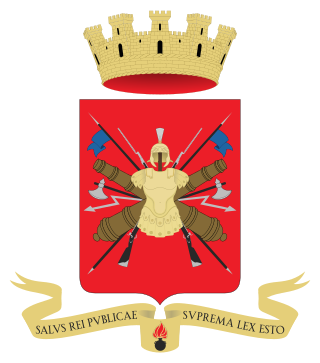
The Italian Army is the land force branch of the Italian Armed Forces. The army's history dates back to the Italian unification in the 1850s and 1860s. The army fought in colonial engagements in China, Libya, Northern Italy against the Austro-Hungarian Empire during World War I, Abyssinia before World War II and in World War II in Albania, Balkans, North Africa, the Soviet Union, and Italy itself. During the Cold War, the army prepared itself to defend against a Warsaw Pact invasion from the east. Since the end of the Cold War, the army has seen extensive peacekeeping service and combat in Afghanistan and Iraq. Its best-known combat vehicles are the Dardo infantry fighting vehicle, the Centauro tank destroyer and the Ariete tank and among its aircraft the Mangusta attack helicopter, recently deployed in UN missions. The headquarters of the Army General Staff are located in Rome opposite the Quirinal Palace, where the president of Italy resides. The army is an all-volunteer force of active-duty personnel.
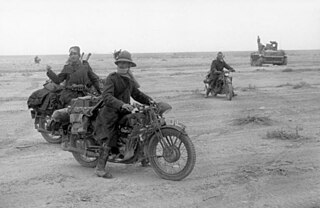
The 1st Army was a Royal Italian Army field army, in World War I, facing Austro-Hungarian and German forces, and in World War II, fighting on the North African front.

The Comando Truppe Alpine or COMTA commands the Mountain Troops of the Italian Army, called Alpini and various support and training units. It is the successor to the 4º Corpo d'Armata Alpino of the Cold War. The Alpini are light Infantry units specializing in Mountain Combat. The subordinate units of the COMTA distinguished themselves during combat in World War I and World War II.

The 5th Infantry Division "Cosseria" was an infantry division of the Royal Italian Army during World War II. The Cosseria was named for the Battle of Cosseria fought in 1796 during the War of the First Coalition. The division recruited primarily in Liguria and its infantry regiments were based in Ventimiglia (89th) and Sanremo (90th), while the artillery regiment was based in Albenga.

The Italian Army in Russia was an army-sized unit of the Regio Esercito which fought on the Eastern Front during World War II between July 1942 and April 1943. The ARMIR was also known as the 8th Italian Army and initially had 235,000 soldiers. The bulk of this force was destroyed by the Soviet Red Army at the Battle of Stalingrad, after which Mussolini withdrew the remnants from Russia to the West.
The article provides an overview of the entire chain of command and organization of the Italian Army after the reform of 1 October 2016 and includes all active units as of 1 July 2019. The Armed Forces of Italy are under the command of the Italian Supreme Defense Council, presided over by the President of the Italian Republic. The Italian Army is commanded by the Chief of the Army General Staff or "Capo di Stato Maggiore dell’Esercito" in Rome.
On March 1, 1984 the Italian Institute for Disarmament, Development and Peace (Istituto di ricerche per il disarmo, lo sviluppo e la pace in Rome published the entire Italian Army order of battle down to company level – this was justified by the radical party as one of its core demands was total disarmament of Europe, even though the data which was published was top secret. The Radical Party dissolved in 1989 and the IRDISP followed suit in 1990. But Radio Radicale has survived, and the OrBat can still be found today on the homepage of the radio.

The Mechanized Brigade "Granatieri di Sardegna" is a mechanized infantry brigade of the Italian Army, based in Rome and central Italy. The brigade fields one of the oldest regiments of the Army and is one of the guard regiments of the President of Italy. The name of the unit dates back to the Kingdom of Sardinia and not the eponymous Mediterranean island of Sardinia. The brigade is part of the Division "Acqui".

The 9th Infantry Division Pasubio was an infantry division of the Royal Italian Army during World War II. The Pasubio was classified as an auto-transportable division, meaning it had some motorized transport, but not enough to move the entire division at once. The division was formed as an infantry division in 1934, reorganized as auto-transportable division in 1939 and mobilized in August 1940. It was named for the battles on Pasubio during World War I. Its 79th Infantry Regiment and 8th Artillery Regiment were made up of men from Verona, while the ranks of the 80th Regiment were filled with men from Mantua. Its I CC.NN. Battalion "Sabauda" was made up of Blackshirt volunteers from Turin.

The 1st Infantry Division "Superga" was an infantry division of the Royal Italian Army during World War II. The Superga was classified as a mountain infantry division, which meant that the division's artillery was moved by pack mules instead of the horse-drawn carriages of line infantry divisions. Italy's real mountain warfare divisions were the six alpine divisions manned by Alpini mountain troops. The Superga recruited primarily from central Piedmont and was based, together with its two infantry regiments, in Turin, while the 5th Artillery Regiment was based in Venaria Reale. The division was and named for the Superga hill near Turin, where members of Italy's Royal House of Savoy were buried in the Basilica of Superga.
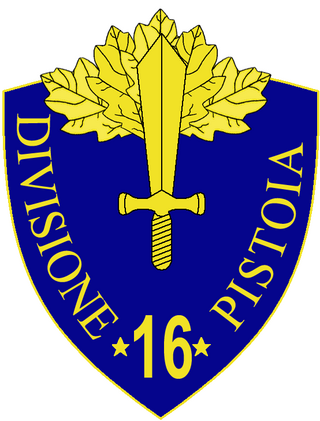
The 16th Infantry Division "Pistoia" was an infantry division of the Royal Italian Army during World War II. The division was named after the city of Pistoia and initially an infantry division, but reorganized to a fully motorized division in 1941. Consequently on 10 October 1941 the division was renamed 16th Motorized Division "Pistoia". The Pistoia had its recruiting area in the central Emilia-Romagna and its headquarters in Bologna. Its two infantry regiments were based in Bologna (35th) and Modena (36th), with the division's artillery regiment based in Bologna.
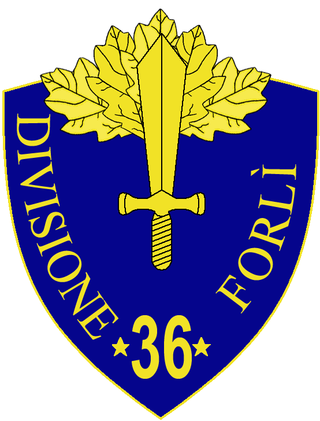
The 36th Infantry Division "Forlì" was a infantry division of the Royal Italian Army during World War II. The Forlì was classified as a mountain infantry division, which meant that the division's artillery was moved by pack mules instead of the horse-drawn carriages of line infantry divisions. Italy's real mountain warfare divisions were the six alpine divisions manned by Alpini mountain troops. The division was formed on 31 March 1939 and named for the city of Forlì. The division was based in Saluzzo and most of its troops were drafted in the surrounding Langhe region in southern Piedmont. The division's two infantry regiments were based in Alba (43rd) and Saluzzo (44th), with the division's artillery regiment also based in Saluzzo.

The 3rd Infantry Division "Ravenna" was a infantry division of the Royal Italian Army during World War II. The Ravenna was classified as a mountain infantry division, which meant that the division's artillery was moved by pack mules instead of the horse-drawn carriages of line infantry divisions. Italy's real mountain warfare divisions were the six alpine divisions manned by Alpini mountain troops. The Ravenna was named for the ancient city of Ravenna and based in the city of Alessandria. Its two infantry regiments were based in Alessandria (37th) and Alba (38th), respectively Alessandria and Tortona from 1939, with the division's artillery regiment also based in Alessandria.
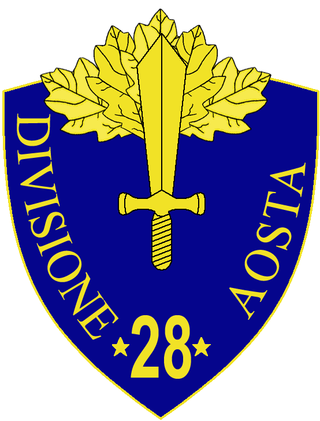
The 28th Infantry Division "Aosta" was an infantry division of the Royal Italian Army during World War II. The Aosta was formed for the first time in 1831 and named for the city of Aosta. The division fought in the Allied invasion of Sicily and its remnants were evacuated to Northern Italy, where the division's remnants were disbanded after the Armistice of Cassibile.
The following is a hierarchical outline for the Italian Army at the end of the Cold War. It is intended to convey the connections and relationships between units and formations.
With the 1975 reforms the Italian Army abolished the regimental level and replaced it with brigades made up of multiple arms. During the reform the army disbanded 48 regimental commands and reduced its force by 87 battalions. A further ten regimental commands were used to raise ten new brigade commands. Ten training centers, which for traditional reasons had carried the names of regiments, were also disbanded. The reduction in units also allowed to mechanize most of the remaining units in Northern Italy and Italy's defense strategy changed from a hold-at-all-costs territorial defense to one of mobile warfare.

Italian Army gorget patches are worn by all army personnel on the collars of the shirts and jackets of their service uniforms and formal uniforms. The gorget patches identify the arm, corps, or speciality within an arm or corps a soldier belongs to. Generals wear golden stars instead of a gorget patches, while army recruits wear silver stars until they are assigned to a unit after basic training. Originally made from colored cloth, respectively embroidered cloth for Granatieri, Carabinieri and general staff members, gorget patches have been made since 1973 from enamelled metal.
The 8th Marching Division was a short-lived division of the Royal Italian Army during World War II. In the Italian military the term "Marching" refers to temporary units based in Italy to manage replacements for the operational units at the front.












